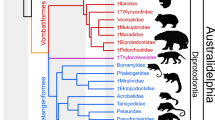Abstract
THE Order Symmetrodonta consists of small Mesozoic therian mammals with tricuspid molars of pretribosphenic type. The order includes species probably ancestral to Jurassic eupantotheres1 and hence to marsupials (Metatheria) and placentals (Eutheria), and it includes less central lineages that have left no known descendants. Symmetrodont fossils are uncommon, and those that are found are mostly fragmentary jaws with teeth. The geologically oldest symmetrodonts are from the Rhaetic of Wales (Kuehneotherium2); Upper Jurassic (Spalacotherium, Tinodon, Eurylambda, Amphidon) and Lower Cretaceous (Spalacotherium, Spalacotheraides, Manchurodon) symmetrodonts are known from Eurasia and North America3–7. Here I report the discovery of the first Upper Cretaceous symmetrodont, from the early Campanian8 Upper Milk River Formation9, Alberta, Canada.
This is a preview of subscription content, access via your institution
Access options
Subscribe to this journal
Receive 51 print issues and online access
$199.00 per year
only $3.90 per issue
Buy this article
- Purchase on Springer Link
- Instant access to full article PDF
Prices may be subject to local taxes which are calculated during checkout
Similar content being viewed by others
References
Mills, J., Proc. Linn. Soc. Lond., 175, 117 (1964).
Kermack, D., Kermack, K., and Mussett, F., J. Linn. Soc. (Zool.), 47, 407 (1968).
Simpson, G. G., Catalogue of the Mesozoic Mammalia in the Geological Department of the British Museum (Brit. Mus. (Nat. Hist.), London, 1928).
Crompton, A., and Jenkins, F., Science, 155, 1006 (1967).
Clemens, W., and Lees, P., in Early Mammals (edit. by Kermack, D., and Kermack, K.), J. Linn. Soc. (Zool. Suppl., No. 1), 50, 117 (1971).
Patterson, B., Fieldiana, Zool., 37, 689 (1955).
Yabe, H., and Shikama, T., Proc. Imp. Acad. Japan, 14, 353 (1938).
Williams, G., and Burk, C., in Geological History of Western Canada (edit. by McCrossan, R., and Glaister, R.), 1969 (Alberta Soc. Petrol. Geol., Calgary, 1964).
Russell, L., and Landes, R., Mem. Geol. Surv. Canad., 223 (1940).
Fox, R., Canad. J. Zool., 47, 1253 (1969).
Fox, R., Canad. J. Earth Sci., 8, 916 (1971).
Fox, R., in Early Mammals (edit. by Kermack, D., and Kermack, K.), J. Linn. Soc. (Zool. Suppl., No. 1), 50, 145 (1971).
Fox, R., Canad. J. Earth Sci. (in the press).
Fox, R., Nature, 227, 630 (1970).
Fox, R., Nature, 220, 1046 (1968).
Shikama, T., Proc. Imp. Acad. Tokyo, 23, 76 (1947).
McKenna, M., Ann. NY Acad. Sci., 167, 217 (1969).
Kielan-Jaworowska, Z., Palaeont. Pol., 19, 171 (1969).
Kielan-Jaworowska, Z., Palaeont. Pol., 21, 35 (1970).
Author information
Authors and Affiliations
Rights and permissions
About this article
Cite this article
FOX, R. An Upper Cretaceous Symmetrodont from Alberta, Canada. Nature 239, 170–171 (1972). https://doi.org/10.1038/239170b0
Received:
Issue Date:
DOI: https://doi.org/10.1038/239170b0
This article is cited by
Comments
By submitting a comment you agree to abide by our Terms and Community Guidelines. If you find something abusive or that does not comply with our terms or guidelines please flag it as inappropriate.



